 |
|
| Longmen Grottoes |
| CCTV.COM 2002-09-03 13:09:16 |
|
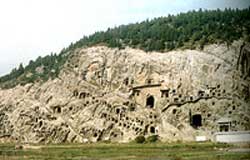 Longmen Grottoes flanks the banks of Yihe River, 12 kilometers south of Luoyang, Henan Province. This religious relic honeycombs the cliffs of the Eastern and Western Hills. Among all grottoes in China, Longmen has the largest amount of statues and grottoes. Longmen Grottoes flanks the banks of Yihe River, 12 kilometers south of Luoyang, Henan Province. This religious relic honeycombs the cliffs of the Eastern and Western Hills. Among all grottoes in China, Longmen has the largest amount of statues and grottoes.
Construction of the grottoes began in the fifth century after the Northern Wei Dynasty (386-534) moved its capital to Luoyang from Tadong in Shanxi Province. Carving went on for 400 years through several dynasties. Longmen has 2,300 grottoes and over 10,000 statues, the best of which were done in Northern Wei and Tang dynasties.
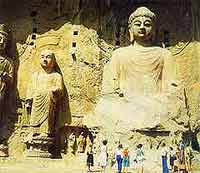 Guyang Cave, being its first, houses the richest amount of niches and statues. Arranged in orderly rows the niches have beside them inscriptions of the carvers. The 2,800 inscriptions surpass all other grottoes in number. The most outstanding are "Twenty Articles of Longmen", which calligraphers regard as the best calligraphy done in Wei tablet style. Guyang Cave, being its first, houses the richest amount of niches and statues. Arranged in orderly rows the niches have beside them inscriptions of the carvers. The 2,800 inscriptions surpass all other grottoes in number. The most outstanding are "Twenty Articles of Longmen", which calligraphers regard as the best calligraphy done in Wei tablet style.
Bingyang Middle Cave is typically Northern Wei. It contains 11 magnificent Buddhist statues. Looking like a temple hall, this cave took 24 years and 800,000 workdays to complete. It was the most splendid and magnificent of caves of Northern Wei. The statues in this cave are done in the Chinese rather than the Indian Gandhara style.
Another outstanding cave is the Lotus Cave. The lotus flower carved on the roof has a 3.6-meter diameter and is 35 cm thick. A lotus flower as big and exquisite as this is not seen in any other grottoes.
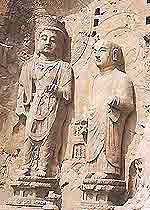 This is an interesting cave called the Cave of Prescriptions. More than 140 prescriptions of Chinese medicine are carved on its walls. They are internal medicine, pediatric, surgical and gynecological prescriptions covering over 40 diseases. They were brought to Japan during the 9th and 10th centuries. The Japanese call them Longmen prescriptions. This is an interesting cave called the Cave of Prescriptions. More than 140 prescriptions of Chinese medicine are carved on its walls. They are internal medicine, pediatric, surgical and gynecological prescriptions covering over 40 diseases. They were brought to Japan during the 9th and 10th centuries. The Japanese call them Longmen prescriptions.
Longmen statues inherited from both Indian and Yungang grotto art which first clashed and then incorporated with Han nationality art of the central plains. Right from the start, they adopted a national and worldly tendency. They donned ample gowns and loose girdles like the Han nationality and the statues looked graceful, refined, and elegant. This transformation quickly influenced all China. Changes occurred later again. The statues in Cave of Prescriptions had robust bodies, big heads, short necks and round shoulders. Thus, Northern Wei statue carving transformed into the Tang-dynasty style.
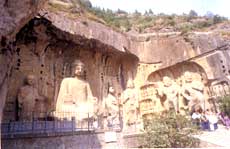 Another upsurge of cave building started in Longmen Grottoes in the Tang Dynasty, that is, from the 7th to the 8th centuries. Another upsurge of cave building started in Longmen Grottoes in the Tang Dynasty, that is, from the 7th to the 8th centuries.
Ten-Thousand-Buddha Cave is a typical cave of the Tang Dynasty. It enshrines Amitabha. Its caisson is dated "First year of the Yonglong reign of Great Tang", that was 680. The inscription on the north wall at the hallway states that Nun Zhiyun was ordered by Emperor Gao Zong, Empress Wu Zetian, the crown prince and other princes to build 15,000 Buddhist statues. The many little statues give the cave an impact of the power of Buddha. They also bring out the religious theme of Buddhist adherents' piety and symbolize that "the emperor is the Buddha".
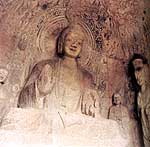 Many caves were hewn on the Eastern Hill in the Tang Dynasty. The 29 arhats in "Temple of Scripture Reading" are about 1.8 meters in height. At first sight, they may look the same, but at close scrutiny, each of them has different features and expressions reflecting the happiness, anger, sadness and joy of the human world. Many caves were hewn on the Eastern Hill in the Tang Dynasty. The 29 arhats in "Temple of Scripture Reading" are about 1.8 meters in height. At first sight, they may look the same, but at close scrutiny, each of them has different features and expressions reflecting the happiness, anger, sadness and joy of the human world.
Vairocana in the Temple of Worshipping Ancestors is the largest in Longmen and most representative of the art of Tang-dynasty carving. The sitting Vairocana is 17.14 meters high. Its head 4 meters and its ears 1.9 meters long. It wears a solemn yet benevolent expression. It sits towering above the secular world. Its stately majesty makes it one of the grandest statues of ancient China. Other 8 big statues are his intelligent disciple Ananda and his eldest disciple Kasyapa who wore a rigorous and discreet expression. Bodhisattva, dressed up in colorful attire, is gracefully beautiful. The Lokapalas are awe-inspiring. And the guardians are ferocious. Each one has its special characteristics. Complementing the principal statue Vairocana, they constitute a complete group of artwork. Apart from being the highest achievement of Tang-dynasty carving art, it is also a monument in the history of Chinese and international art.
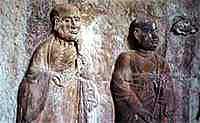 On the base of Vairocana is inscribed "Built by Emperor Gao Zong of Great Tang. Empress Wu Zetian contributed her cosmetic money." Many caves in the Northern Wei and Tang dynasties were built at imperial orders. So, an "imperial style" is the outstanding feature of Longmen Grottoes. On the base of Vairocana is inscribed "Built by Emperor Gao Zong of Great Tang. Empress Wu Zetian contributed her cosmetic money." Many caves in the Northern Wei and Tang dynasties were built at imperial orders. So, an "imperial style" is the outstanding feature of Longmen Grottoes.
After 1,500 years, Longmen Grottoes is still magnificent. Its rich content reflects from different aspects the development and changes in ancient China's politics, economy, religion and culture. It has contributed tremendously to the creation and development of Chinese grotto art.
|
|
Editor: Liu Baoyin CCTV.com
|
|
|
|
|
|
 |









